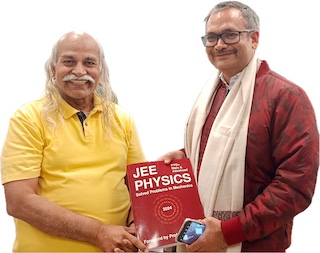Measurement Errors
The purpose of measurement is to find the true value of a physical quantity. However, the measured value usually differs from the true value. The difference between the true value and the measured value is called measurement error (or inaccuracy in measurement). These errors can come from a variety of sources, including limitations in the equipment, the skill of the person making the measurement, and environmental conditions.
Types of Errors
The systematic error tend to be in one direction (either positive or negative) when measurement is repeated. The random error is irregular in nature with respect to its sign as well as magnitude. The least count of a measuring instrument is the smallest value that can be measured by it.
The absolute error of a measurement is the magnitude of the difference between the true value of the quantity and its measured value. Generally, arithmetic mean of several measurements $a_1, a_2, a_3,\ldots, a_n$ is taken as the true value. Thus, absolute error of $i^\mathrm{th}$ measurement is \begin{align} \Delta a_i & =\left|a_i-a_\text{mean} \right| \\ &=\left|a_i-\frac{1}{n}\sum_{i=1}^n a_i\right|. \end{align} The mean absolute error is the arithmetic mean of the absolute errors i.e., \begin{align} \Delta a_\text{mean}=\frac{1}{n}\sum_1^n \Delta a_i. \end{align}
The relative error (RE) is the ratio of the mean absolute error $\Delta a_\text{mean}$ to the mean value $a_\text{mean}$ of the quantity measured i.e. \begin{align} \text{RE}&=\frac{\Delta a_\text{mean}}{a_\text{mean}} \\ &=\frac{1}{a_\text{mean}}\left(\frac{1}{n}\sum_{i=1}^n \Delta a_i\right). \end{align}
The percentage error (PE) is the relative error expressed in percent i.e., \begin{align} \text{PE}=\left(\frac{\Delta a_\text{mean}}{a_\text{mean}}\right)\times100\%. \end{align}
Error Propagation
- Error of a sum or a difference: When two quantities are added or subtracted, the absolute error in the final result is the sum of the absolute errors in the individual quantities.
- Error of a product or a quotient: When two quantities are multiplied or divided, the relative error in the result is the sum of the relative errors in the multipliers.
- The relative error in the physical quantity raised the the power $k$ is the $k$ times the relative error in the individual quantity.
Problems from IIT JEE
Problem (IIT JEE 2004): A wire has a mass $m=0.3\pm 0.003\;\mathrm{g}$, radius $r=0.5\pm 0.005\;\mathrm{mm}$ and length $l=6\pm 0.06\;\mathrm{cm}$. The maximum percentage error in the measurement of its density is
- 1
- 2
- 3
- 4
Solution: The density of a wire of mass $m$, length $l$, and radius $r$ is given by \begin{align} \rho=\frac{m}{V}=\frac{m}{\pi r^2 l}. \end{align} Differentiate above equation and divide it by $\rho$ to get \begin{align} \left.\frac{\Delta \rho}{\rho}\right|_\text{max} =\left|\frac{\Delta m}{m}\right|+2\left|\frac{\Delta r}{r}\right|+\left|\frac{\Delta l}{l}\right|. \end{align} From the given data, $m=0.3\;\mathrm{g}$, $\Delta m=0.003\;\mathrm{g}$, $r=0.5\;\mathrm{mm}$, $\Delta r=0.005\;\mathrm{mm}$, $l=6\;\mathrm{cm}$, and $\Delta l=0.06\;\mathrm{cm}$. Substitute the values in above equation to get \begin{align} \frac{\Delta \rho}{\rho} &=\frac{0.003}{0.3}+\frac{2\times 0.005}{0.5}+\frac{0.06}{6} \\ &=0.04=4\%.\nonumber \end{align}
Problem (IIT JEE 2015): The energy of a system as a function of time $t$ is given as $E(t)=A^2\exp(-\alpha t)$, where $\alpha=0.2\;\mathrm{s^{-1}}$. The measurement of A has an error of $1.25\%$. If the error in the measurement of time is $1.50\%$, the percentage error in the value of $E(t)$ at $t=5\;\mathrm{s}$ is $\ldots$.
Solution: Differentiate the expression $E(t)=A^2e^{-\alpha t}$ to get \begin{align} \mathrm{d} E=2 A e^{-\alpha t}\,\mathrm{d} A-A^2\alpha e^{-\alpha t}\,\mathrm{d} t. \end{align} Divide above equation by $E(t)$ and simplify to get \begin{align} \frac{\mathrm{d} E}{E}=2\;\frac{\mathrm{d} A}{A}-\alpha \mathrm{d} t=2\;\frac{\mathrm{d} A}{A}-\alpha t\; \frac{\mathrm{d} t}{t}. \end{align} The error in measurement of a parameter $x$ is generally defined by \begin{align} x_\text{actual}=x_\text{measured}\pm \Delta x,\nonumber \end{align} where $\Delta x$ is a small positive number representing measurement error. Let $\Delta A$ and $\Delta t$ be the measurement errors (both positives) in $A$ and $t$. From above equation, $\mathrm{d}E$ is maximum when $\mathrm{d}A=\Delta A$ and $\mathrm{d}t=-\Delta t$. Thus, the percentage relative error in $E(t)$ is given by \begin{align} \frac{\Delta E}{E} &=2\;\frac{\Delta A}{A}+\alpha t \;\frac{\Delta t}{t} \\ &=2(1.25\%)+(0.2)(5)(1.5\%) \\ &=4\%.\nonumber \end{align}
